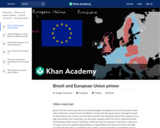
A primer on Brexit, the European Union and the Eurozone.
- Subject:
- Economics
- Social and Behavioral Sciences
- Material Type:
- Lesson
- Provider:
- Khan Academy
- Provider Set:
- Khan Academy
- Author:
- Sal Khan
- Date Added:
- 08/10/2021

A primer on Brexit, the European Union and the Eurozone.
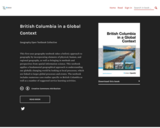
Over the course of four days in June, 2014, five faculty members from across British Columbia supported by a facilitator, librarian, researcher, illustrator, programmer, and instructional designer created this book. This involved drawing on our own research, teaching, and experience and working with the team to put it all together into an accessible online format.
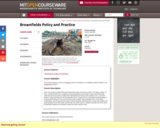
There are several hundred thousand Brownfield sites across the country. The large number of sites, combined with how a majority of these properties are located in urban and historically underserved communities, dictate that redevelopment of these sites stands to be a common theme in urban planning for the foreseeable future. Students form a grounded understanding of the Brownfield lifecycle: how and why they were created, their potential role in community revitalization, and the general processes governing their redevelopment. Using case studies and guest speakers from the public, private and non-profit sectors, students develop and hone skills to effectively address the problems posed by these inactive sites.

What I can buy with my income. Created by Sal Khan.
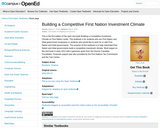
This is the first edition of the open text book Building a Competitive Investment Climate on First Nation Lands. This textbook is for students who are First Nation and tribal government employees or students who would like to work for or with First Nation and tribal governments. The purpose of this textbook is to help interested First Nation and tribal governments build a competitive investment climate. Work began on this text book in early 2012 with a generous grant from the Donner Canadian Foundation. Financial support was also provided by the First Nations Tax Commission and the Tulo Centre.
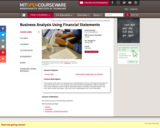
Uses a case approach to develop a framework for business analysis. Provides students with tools for business analysis, including strategic, accounting, financial, and prospective analysis. Concepts are then applied to a number of decision-making contexts, such as credit analysis, investor communications, merger analysis, financial policy decisions, and securities analysis. From the Course Description: Course Description The purpose of this class is to advance your understanding of how to use financial information to value and analyze firms. We will apply your economics/accounting/finance skills to problems from today's business news to help us understand what is contained in financial reports, why firms report certain information, and how to be a sophisticated user of this information.
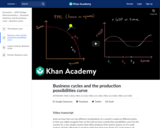
This video demonstrates how different points of the business cycle correspond to the production possibilities curve. The discussion includes unemployment, inflation, expansions, recessions and economic growth.

This is a playlist of videos from the Creative Commons Global Summit 2023. Videos include sessions that were either pre-recorded or recorded live in Mexico City during 3–6 October 2023.

Video of Sal on CNN on October 10th discussing the credit crisis and a potential solution to it. Created by Sal Khan.

Recall that the tax multiplier and expenditure multiplier magnify the effect of any change in spending or taxes. In this video, we use that fact to calculate the amount of spending or tax change necessary to close output gaps.

In this video we take a slightly different approach to understanding the difference between real and nominal values: find the value of an asset in a previous year's dollars. Created by Sal Khan.
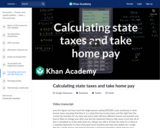
How to calculate state taxes and take-home pay.Created by Sal Khan.
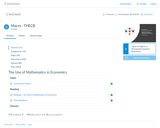
Textbook
The book for this course is Macroeconomics and uses a book from OpenStax which was created by Rice University.
Videos
Images for videos come from the following sources with voice over from Professor Richard Gosselin at Houston Community College who is solely responsible for their content. There are 179 videos for the macroeconomics course with an average run time of about five minutes each. They were produced using three sources - desktop screen capturing via Screenflow which is a product of Telestream, as well as One Button Studio and the Learning Glass for live in-person mini-lectures filmed in a studio. Nearly all the video have been closed-captioned for the hearing impaired using professionals rather than automation. There are also downloadable transcripts embedded for each video and a download feature for users. Houston Community College footed the expense of the closed-captioning service. I would like to thank the college administration as well as Ruben Duran, Senior Media Developer at the college for assisting with this.
OpenStax Macroeconomics, Second Edition
Principles of Economics is adapted from a work produced and distributed under a Creative Commons license
(CC BY-NC-SA) in 2011 by a publisher who has requested that they and the original author not receive attribution. This adapted edition is produced by the University of Minnesota Libraries Publishing through the eLearning Support Initiative. This adaptation has reformatted the original text and replaced some images and figures to make the resulting whole more shareable. This adaptation has not significantly altered or updated the original 2011 text. This work is made available under the terms of a Creative Commons Attribution-NonCommercial-ShareAlike license.
Test Bank
The original test bank provided by Open Stax provided 1158 questions, 955 were multiple choice and 203 were short answer questions. Under this grant there were no additional short answer questions added however, there are now 1418 questions in the new test bank which is the result of adding 260 questions of the following variety - multiple choice, fill in the blank, numerical questions, multiple drop-down questions, multiple-response questions, matching and formula questions which present each student with different values and parameters. Images in the test bank, unless otherwise noted are licensed under the Creative Commons and most are the product of unknown authors.
Review PowerPoint Slides
These were provided by Intellus Learning Open Courses
This work is licensed under a Creative Commons Attribution 4.0 International (Links to an external site.) License. The material for these slides and the image come directly from Macroeconomics OpenStax, Second edition.
Discussion Questions
These were authored by Richard Gosselin at Houston Community College and are licensed under the Creative Commons. There are over 70 discussion questions available.
Flash Card Powered by Quizlet
These were authored by Richard Gosselin with a couple of exceptions. They are based on the terms in Macroeconomics, Second edition. They are also licensed under the Creative Commons and are freely distributable. There are 21 such quizzes, one for each chapter.
Excel Exercises and Videos
26 Excel assignments were created including practice assignments and videos to assist students with basic features of Excel which help them create a file, save data, sort data, create tables, line graphs, bar graphs and pie chart and much more.
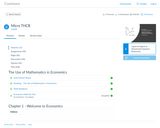
Textbook
The book for this course is Microeconomics OpenStax which was created by Rice University.
Videos
Images for videos come from the following sources with voice over from Professor Richard Gosselin at Houston Community College who is solely responsible for their content. There are 161 videos for the macroeconomics course with an average run time of about five minutes each. They were produced using three sources - desktop screen capturing via Screenflow which is a product of Telestream, as well as One Button Studio and the Learning Glass for live in-person mini-lectures filmed in a studio. Nearly all the video have been closed-captioned for the hearing impaired using professionals rather than automation. There are also downloaded transcripts embedded for each video and a download feature for users. Houston Community College footed the expense of the closed-captioning service. I would like to thank the college administration as well as Ruben Duran, Senior Media Developer at the college for assisting with this.
OpenStax Macroeconomics, Second Edition
Principles of Economics is adapted from a work produced and distributed under a Creative Commons license
(CC BY-NC-SA) in 2011 by a publisher who has requested that they and the original author not receive attribution. This adapted edition is produced by the University of Minnesota Libraries Publishing through the eLearning Support Initiative. This adaptation has reformatted the original text and replaced some images and figures to make the resulting whole more shareable. This adaptation has not significantly altered or updated the original 2011 text. This work is made available under the terms of a Creative Commons Attribution-NonCommercial-ShareAlike license.
Test Bank
The original test bank provided by Open Stax provided 1333 questions, 1136 were multiple choice and 197 were short answer questions. Under this grant there were no additional short answer questions added however, there are now 1615 questions in the new test bank which is the result of adding 282 questions of the following variety - multiple choice, fill in the blank, numerical questions, multiple drop-down questions, multiple-response questions, matching and formula questions which present each student with different values and parameters. Images in the test bank, unless otherwise noted are licensed under the Creative Commons and most are the product of unknown authors.
Review PowerPoint Slides
These were provided by Intellus Learning Open Courses
This work is licensed under a Creative Commons Attribution 4.0 International (Links to an external site.)Links to an external site. License. The material for these slides and the image come directly from Microeconomics OpenStax, Second edition.
Discussion Questions
These were authored by Richard Gosselin at Houston Community College and are licensed under the Creative Commons. There are over 70 discussion questions available.
Flash Card Powered by Quizlet
These were authored by Richard Gosselin with a couple of exceptions. They are based on the terms in Macroeconomics, Second edition. They are also licensed under the Creative Commons and are freely distributable. There are 20 such quizzes, one for each chapter.
Excel Exercises and Videos
26 Excel assignments were created including practice assignments and videos to assist students with basic features of Excel which help them create a file, save data, sort data, create tables, line graphs, bar graphs, and pie chart and much more.
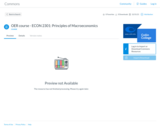
This is a Principles of Macroeconomics course utilizing exclusively Open Educational Resources and designed in Canvas. This course is mapped to the Learning Outcomes for ECON 2301 as established under the Texas Higher Education Coordinating Board Academic Course Guide Manual. This course is based on Openstax Principles of Macroeconomics 2e textbook and incorporates key components from EDUC 1301: Learning Frameworks, designed to enhance the student’s experience as well as to improve overall student learning.
The course was developed by a faculty team from Collin College as part of the Texas Higher Education Coordinating Board OER Course Development and Implementation Grant Program.

Your town is holding a mayoral election and the stakes have never been higher. You suspect one of the candidates will begin pushing false information to swing the election. As the cybersecurity expert, your job is to inoculate the townspeople against false information. First, you must learn the strategies of disinformation trolls. Claire Wardle explores the tactics of disinformation campaigns

Capacity to Connect: Supporting Students’ Mental Health and Wellness includes a facilitator’s guide with handouts and a PowerPoint presentation. This adaptable training resource covers foundational mental health and wellness knowledge for post-secondary faculty and staff and ways to support students in distress. It can be used for two-hour online or in-person training or for self-study.

An introduction to the book Capital by Thomas Piketty. Created by Sal Khan.
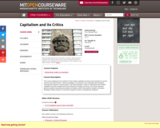
Subject addresses the evolution of the modern capitalist economy and evaluates its current structure and performance. Various paradigms of economics are contrasted and compared (neoclassical, Marxist, socioeconomic, and neocorporate) in order to understand how modern capitalism has been shaped and how it functions in today's economy. Readings include classics in economic thought as well as contemporary analyses. Subject stresses general analytic reasoning and problem formulation rather than specific analytic techniques. May not be used for economics concentration. One economics HASS-D subject may be used as an economics elective for the economics major and minor. This course examines the implications of economic theories for social and political organization in the context of the historical evolution of industrial societies. Among the authors whose theories will be discussed are Ayn Rand, Milton Friedman, Karl Marx, Max Weber, Joseph Schumpeter, and John Kenneth Galbraith. Emphasis will be placed on class discussion of specific texts. Students will be encouraged to ground their views in concrete textual and empirical material and to consider the implications of different arguments for the understanding of personal, political, and economic events today.
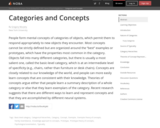
Text and links to all ancillary materials for Module 18